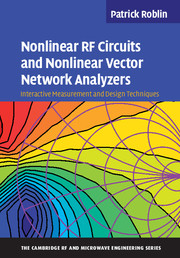 Nonlinear RF Circuits and Nonlinear Vector Network Analyzers
Nonlinear RF Circuits and Nonlinear Vector Network Analyzers Book contents
- Frontmatter
- Contents
- Preface
- Dedication
- Acknowledgments
- 1 Wireless signals
- 2 Large-signal vector measurement techniques with NVNAs
- 3 Device modeling and verification with NVNA measurements
- 4 Characterization and modeling of memory effects in RF power transistors
- 5 Interactive loadline-based design of RF power amplifiers
- 6 Behavioral modeling
- 7 Kurokawa theory of oscillator design and phase-noise theory
- 8 Design, modeling, and linearization of mixers, modulators, and demodulators
- 9 Linearization of RF power amplifiers with memory
- Index
- References
8 - Design, modeling, and linearization of mixers, modulators, and demodulators
Published online by Cambridge University Press: 05 July 2011
- Frontmatter
- Contents
- Preface
- Dedication
- Acknowledgments
- 1 Wireless signals
- 2 Large-signal vector measurement techniques with NVNAs
- 3 Device modeling and verification with NVNA measurements
- 4 Characterization and modeling of memory effects in RF power transistors
- 5 Interactive loadline-based design of RF power amplifiers
- 6 Behavioral modeling
- 7 Kurokawa theory of oscillator design and phase-noise theory
- 8 Design, modeling, and linearization of mixers, modulators, and demodulators
- 9 Linearization of RF power amplifiers with memory
- Index
- References
Summary
This chapter is concerned with the system design, behavioral modeling, experimental characterization, balancing, and linearization of I–Q modulators and mixers. The K-parameters are first introduced for the purpose of linear modeling and balancing. The extraction of the K-matrix from LSNA measurements and a modulator–demodulator chain is discussed. The polyphase up-converter topology which permits the realization of linear single-sideband mixers is introduced next. The nonlinear modeling of the single-sideband mixer is then discussed. Finally the linearization of single-sideband mixers using the poly-harmonic predistortion technique is presented. These techniques offer some interesting options for the filterless implementation of wideband software-defined radio (SDR).
Vector characterization of an I–Q modulator
Balancing of an I–Q modulator
The balancing of I–Q modulators and demodulators is of critical importance in wireless systems, especially for modern multi-carrier techniques (OFDM) employing higher-order modulations such as QAM-64. This problem has been approached from the receiver side using adaptive equalization techniques using known preambles [1] [2]. Balancing is also of importance in multi-band predistortion linearization of the transmitter power amplifiers. As we shall see in Chapter 9 when introducing a frequency-selective predistortion linearization algorithm that differentially linearizes the signal in different bands [3], a balanced modulator is required in order for this linearization scheme to be effective.
An effective technique has been developed for balancing modulators [4]. This approach relies on the initial K-matrix modeling of I–Q modulators [5].
Information
- Type
- Chapter
- Information
- Nonlinear RF Circuits and Nonlinear Vector Network AnalyzersInteractive Measurement and Design Techniques, pp. 237 - 261Publisher: Cambridge University PressPrint publication year: 2011